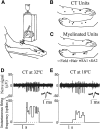Human C-tactile afferents are tuned to the temperature of a skin-stroking caress
- PMID: 24553929
- PMCID: PMC3931502
- DOI: 10.1523/JNEUROSCI.2847-13.2014
Human C-tactile afferents are tuned to the temperature of a skin-stroking caress
Abstract
Human C-tactile (CT) afferents respond vigorously to gentle skin stroking and have gained attention for their importance in social touch. Pharmacogenetic activation of the mouse CT equivalent has positively reinforcing, anxiolytic effects, suggesting a role in grooming and affiliative behavior. We recorded from single CT axons in human participants, using the technique of microneurography, and stimulated a unit's receptive field using a novel, computer-controlled moving probe, which stroked the skin of the forearm over five velocities (0.3, 1, 3, 10, and 30 cm s(-1)) at three temperatures (cool, 18 °C; neutral, 32 °C; warm, 42 °C). We show that CTs are unique among mechanoreceptive afferents: they discharged preferentially to slowly moving stimuli at a neutral (typical skin) temperature, rather than at the cooler or warmer stimulus temperatures. In contrast, myelinated hair mechanoreceptive afferents proportionally increased their firing frequency with stroking velocity and showed no temperature modulation. Furthermore, the CT firing frequency correlated with hedonic ratings to the same mechano-thermal stimulus only at the neutral stimulus temperature, where the stimuli were felt as pleasant at higher firing rates. We conclude that CT afferents are tuned to respond to tactile stimuli with the specific characteristics of a gentle caress delivered at typical skin temperature. This provides a peripheral mechanism for signaling pleasant skin-to-skin contact in humans, which promotes interpersonal touch and affiliative behavior.
Keywords: C-fiber; human; low-threshold mechanoreceptor; somatosensory; thermal; touch.
Figures


References
-
- Arens E, Zhang H. The skin's role in human thermoregulation and comfort. In: Pan N, Gibson P, editors. Thermal and moisture transport in fibrous materials. Cambridge, UK: Woodhead Publishing Ltd; 2006. pp. 560–602.
-
- Bessou P, Burgess PR, Perl ER, Taylor CB. Dynamic properties of mechanoreceptors with unmyelinated (C) fibers. J Neurophysiol. 1971;34:116–131. - PubMed
Publication types
MeSH terms
LinkOut - more resources
Full Text Sources
Other Literature Sources
Research Materials
